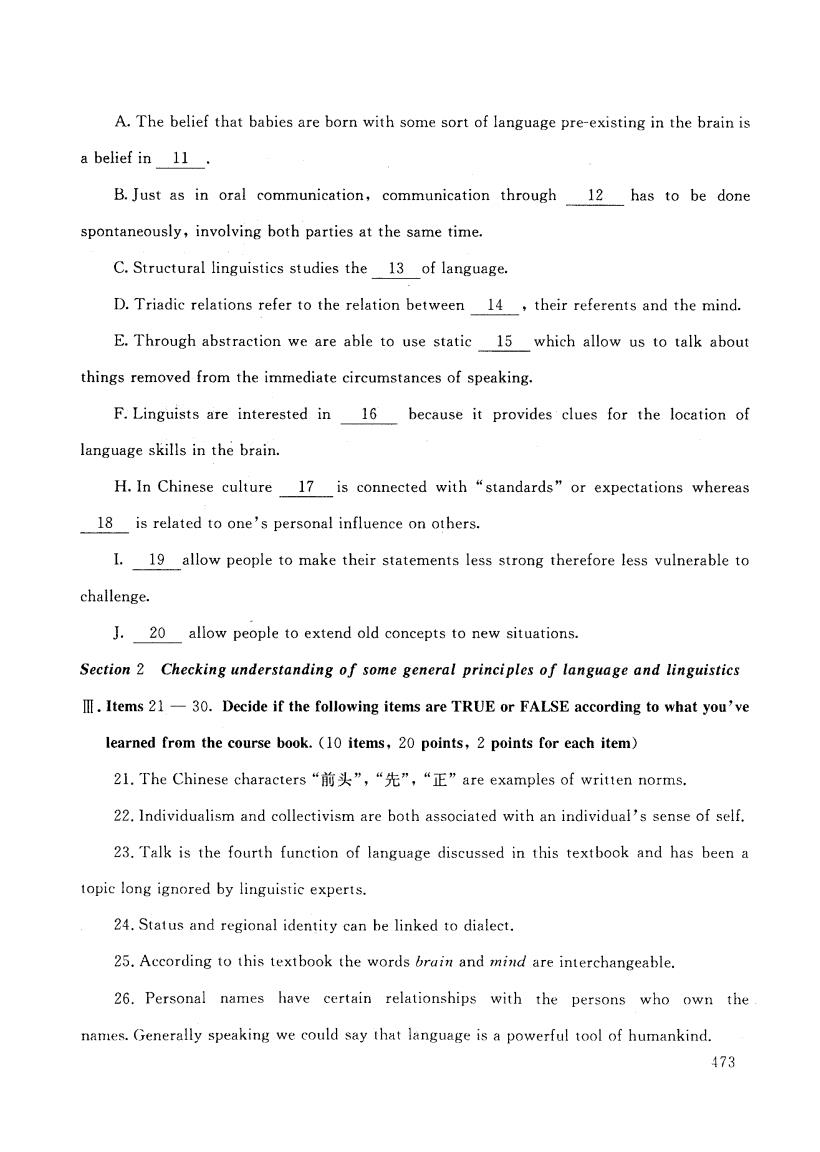正在加载图片...

A.The belief that babies are born with some sort of language pre-existing in the brain is a belief in 11. B.Just as in oral communication,communication through 12 has to be done spontaneously,involving both parties at the same time. C.Structural linguistics studies the 13 of language. D.Triadic relations refer to the relation between 14,their referents and the mind. E.Through abstraction we are able to use static 15 which allow us to talk about things removed from the immediate circumstances of speaking. F.Linguists are interested in 16 because it provides clues for the location of language skills in the brain. H.In Chinese culture 17 is connected with "standards"or expectations whereas 18 is related to one's personal influence on others. I.19 allow people to make their statements less strong therefore less vulnerable to challenge. J.20 allow people to extend old concepts to new situations. Section 2 Checking understanding of some general principles of language and linguistics III.Items 21-30.Decide if the following items are TRUE or FALSE according to what you've learned from the course book.(10 items,20 points,2 points for each item) 2i.The Chinese characters“前头”,“先”,“正”are examples of written norms.. 22.Individualism and collectivism are both associated with an individual's sense of self. 23.Talk is the fourth function of language discussed in this textbook and has been a topic long ignored by linguistic experts. 24.Status and regional identity can be linked to dialect. 25.According to this textbook the words brain and mind are interchangeable. 26.Personal names have certain relationships with the persons who own the names.Generally speaking we could say that language is a powerful tool of humankind. 473A. The belief that babies are born with some sort of language pre-existing in the brain is a belief in 11 B. Just as in oral communication,communication through 12 has to be done spontaneously, involving both parties at the same time. C. Structural linguistics studies the 13 of language. U. Triadic relations refer tothe ar e relation between E. Through abstraction we able to use static their referents and the mind. which allow us to talk about 一 1 口 J改 ‘ 一 1 1 things removed from the immediate circumstances of speaking. F. Linguists are interested in 16 because it provides clues for the location of language skills in the brain. H. In Chinese culture 17 is connected with“standards" or expectations whereas 18 is related to one’s personal influence on others. I. 19 allow people to make their statements less strong therefore less vulnerable to challenge. J 20 allow people to extend old concepts to new situations. Section 2 Checking understanding of some general principles of language and linguistics m.Items 21一 30. Decide if the following items are TRUE or FALSE according to what you've learned from the course book.(10 items, 20 points, 2 points for each item) 21. "the Chinese characters“前头” 22. Individualism and collectivism “先”,“正”are examples of written norms. are both associated with an individual’s sense of self. 23. Talk is the fourth function of language discussed in this textbook and has been a topic long ignored by linguistic experts. Status and regional identity can he linked to dialect. According to this textbook the words bruit and ynirttl are interchangeable. . ‘ 月任 ︼0 夕 臼 9 口 26. Personal names have certain relationships with the persons who own the names. Generally speaking、V e could say that languageIS a powerful tool of humankind. 173